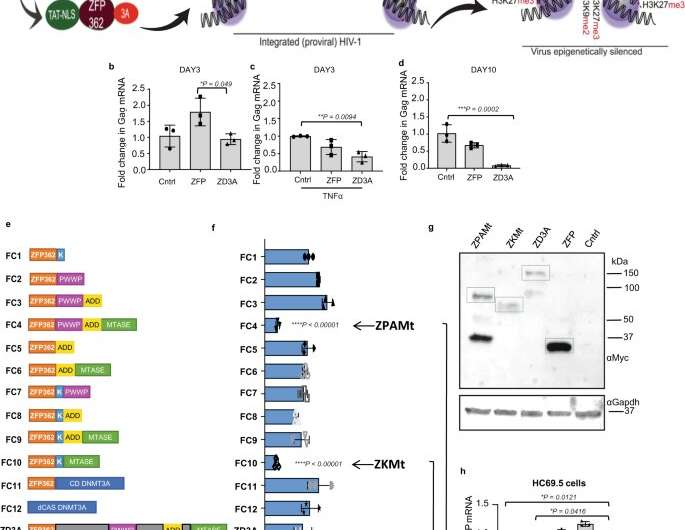Fig. 1: Screening of potent repressors of HIV-1 derived from fusion of ZFP362 and combination of repressor domains. a Schematic representation of the design of the ZD3A constructs leading to ZD3A protein. The NLS containing the ZFP362 domain can bind HIV-1 LTR promoter specifically and DNMT3A can recruit epigenetic silencing complexes. The binding of ZFP362-DNMT3A (ZD3A) can lead to long-term epigenetic transcriptional repression of the LTR represented by methylated CpG DNA and repressive histone methylation (right). b The effect of transfection of ZFP and ZD3A constructs in chronically infected Jurkat (CHI-Ju) cells was measured via RT-qPCR for Gag mRNA at 3 days post-treatment. c Measurement of Gag mRNA from TNFα activated CHI-Ju cells three days after transfection with ZD3A. d The effect of transfection of constructs ZFP and ZD3A in chronically infected Jurkat (CHI-Ju) cells 10 days post-treatment was measured by RT-qPCR for Gag mRNA. e A schematic is shown here depicting the 12 different constructs developed and assessed consisting of ZFP362 with one or more repressor domains like KRAB(K), PWWP, ADD, Methyltransferase (Mtase), Catalytic Domain (CD) of DNMT3A fusions, and the full-length DNMT3a (ZD3A) and control ZFP-362. f CHI-Ju cells were transfected with those fusion constructs depicted in (e) and RT-qPCR for Gag mRNA 10 days post-transfection revealed FC4 and FC10 to be the most potent repressors of LTR activity. FC4 will henceforth be referred to as ZPAMt after constituent ZFP362, PWWP, ADD, and Mtase domains, and FC10 will be referred to as KMt after constituent ZFP362, KRAB, and Mtase domains. g Western blot for Myc tag confirmed the expression of ZPAMt, ZKMt, ZD3A, and ZFP. Representative blot of n = 3 biological replicates (h) LTR driven GFP mRNA expression level measured after overexpression of ZPAMt and ZKMt in microglial cell line HC69.5 Data are represented as mean ± standard deviation (SD) in b–d, f, and h. p-values by one-way ANOVA followed by Tukey’s multiple comparisons post hoc test. For b–d, f, and h the error bars indicate the standard deviation of triplicate treated samples and experiments were repeated twice. ****p ≤ 0.0001. Source data are provided as a source data file. Credit: DOI: 10.1038/s41467-021-25839-2
Researchers at City of Hope, a world-renowned research and treatment organization for cancer and diabetes, and Menzies Health Institute Queensland at Griffith University have developed a novel anti-HIV protein that suppressed HIV levels in the bone marrow, spleen and brain of mice and prevented the virus from replicating in those regions, according to a new study published in Nature Communications.
Their research demonstrates that scientists could engineer nanosized parts of cells called exosomes to carry therapeutic cargo to hard-to-reach places, including the nearly impenetrable blood-brain barrier. This innovative delivery system paves the way for a future where it's conceivable that engineered exosomes could carry cargo that either suppress infectious diseases or restructure genetic material so that pathogens are rendered harmless.
"This innovative technology could become a viable way to deliver therapies not only for HIV but also for other diseases, including ones that affect the brain, such as Alzheimer's and Parkinson's," said Professor Kevin Morris, from City of Hope's Center for Gene Therapy and Griffith University's School of Pharmacy and Medical Sciences. Morris is senior author of the new study.
Human immunodeficiency virus attacks cells that help the body fight infection, making an individual more vulnerable to other infections and diseases. Many researchers believe one way to cure HIV is to "block and lock" the disease in a process that obstructs the ability of the virus to replicate and locks it in a dormant state.
"The ZPAMt HIV protein repressor we developed is packaged into exosome nanoparticles and can enter cells where it epigenetically silences HIV," Morris said. "We show that these nanoparticles can systemically 'block and lock' HIV expression. This is the first time that block and lock has been successfully delivered to treat HIV in vivo in the brain."
HIV can enter the human body in a dormant-like state; it is able to hide from the body's immune system and evade treatments. Then, it can reactivate later. HIV hiding in the brain is especially difficult to treat because of the blood-brain barrier, which prevents both toxins and therapies from entering the brain.
Currently, there is no cure for HIV, so once someone contracts it, he or she will have it for life. An estimated 1.19 million people in the United States had HIV at the end of 2019, according to the Center for Disease Control and Prevention. In Australia there were 29,045 people living with HIV in 2019 according to the Australian Federation of AIDS Organisations.
More information: Surya Shrivastava et al, Exosome-mediated stable epigenetic repression of HIV-1, Nature Communications (2021). DOI: 10.1038/s41467-021-25839-2
Journal information: Nature Communications
Provided by Griffith University
























